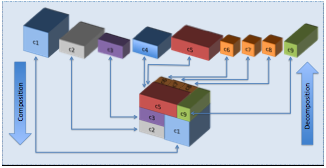
The Defense Advanced Research Projects Agency (DARPA) is a research and development agency of the United States Department of Defense responsible for the development of emerging technologies for use by the military.

Containerization is a system of intermodal freight transport using intermodal containers. Containerization, also referred as container stuffing or container loading, is the process of unitization of cargoes in exports. Containerization is the predominant form of unitization of export cargoes, as opposed to other systems such as the barge system or palletization. The containers have standardized dimensions. They can be loaded and unloaded, stacked, transported efficiently over long distances, and transferred from one mode of transport to another—container ships, rail transport flatcars, and semi-trailer trucks—without being opened. The handling system is mechanized so that all handling is done with cranes and special forklift trucks. All containers are numbered and tracked using computerized systems.

Logistics is the part of supply chain management that deals with the efficient forward and reverse flow of goods, services, and related information from the point of origin to the point of consumption according to the needs of customers. Logistics management is a component that holds the supply chain together. The resources managed in logistics may include tangible goods such as materials, equipment, and supplies, as well as food and other consumable items.

A port is a maritime facility comprising one or more wharves or loading areas, where ships load and discharge cargo and passengers. Although usually situated on a sea coast or estuary, ports can also be found far inland, such as Hamburg, Manchester and Duluth; these access the sea via rivers or canals. Because of their roles as ports of entry for immigrants as well as soldiers in wartime, many port cities have experienced dramatic multi-ethnic and multicultural changes throughout their histories.

An intermodal container, often called a shipping container, or a freight container, (or simply ”container”) is a large standardized container designed and built for intermodal freight transport, meaning these containers can be used across different modes of transport – such as from ships to trains to trucks – without unloading and reloading their cargo. Intermodal containers are primarily used to store and transport materials and products efficiently and securely in the global containerized intermodal freight transport system, but smaller numbers are in regional use as well. It is like a boxcar that does not have wheels. Based on size alone, up to 95% of intermodal containers comply with ISO standards, and can officially be called ISO containers. These containers are known by many names: cargo container, sea container, ocean container, container van or sea van, sea can or C can, or MILVAN, or SEAVAN. The term CONEX (Box) is a technically incorrect carry-over usage of the name of an important predecessor of the ISO containers: the much smaller steel CONEX boxes used by the U.S. Army.

The National Physical Laboratory (NPL) is the national measurement standards laboratory of the United Kingdom. It sets and maintains physical standards for British industry.

In transportation, freight refers to goods conveyed by land, water or air, while cargo refers specifically to freight when conveyed via water or air. In economics, freight refers to goods transported at a freight rate for commercial gain. The term cargo is also used in case of goods in the cold-chain, because the perishable inventory is always in transit towards a final end-use, even when it is held in cold storage or other similar climate-controlled facilities, including warehouses.

Donald Watts Davies, was a Welsh computer scientist who was employed at the UK National Physical Laboratory (NPL).
The CYCLADES computer network was a French research network created in the early 1970s. It was one of the pioneering networks experimenting with the concept of packet switching and, unlike the ARPANET, was explicitly designed to facilitate internetworking.

Rail freight transport is the use of railways and trains to transport cargo as opposed to human passengers.
Johor Port is a port in Pasir Gudang, Johor, Malaysia, built in 1977. It is an integrated multi-purpose port facility providing bulk cargo, container and general cargo services. It is the world's largest palm oil terminal and ranks third globally in terms of LME cargo volume.

The AMPRNet or Network 44 is used in amateur radio for packet radio and digital communications between computer networks managed by amateur radio operators. Like other amateur radio frequency allocations, an IP range of 44.0.0.0/8 was provided in 1981 for Amateur Radio Digital Communications and self-administered by radio amateurs. In 2001, undocumented and dual-use of 44.0.0.0/8 as a network telescope began, recording the spread of the Code Red II worm in July 2001. In mid-2019, part of IPv4 range was sold off for conventional use, due to IPv4 address exhaustion.

A computer network is a set of computers sharing resources located on or provided by network nodes. Computers use common communication protocols over digital interconnections to communicate with each other. These interconnections are made up of telecommunication network technologies based on physically wired, optical, and wireless radio-frequency methods that may be arranged in a variety of network topologies.

Packet Clearing House (PCH) is the international nonprofit organization responsible for providing operational support and security to critical Internet infrastructure, including Internet exchange points and the core of the Domain Name System. The organization also works in the areas of cybersecurity coordination, regulatory policy and Internet governance.
APM Terminals is a port operating company headquartered in The Hague, Netherlands. A unit of Danish shipping company Maersk's Transport and Logistics division, it manages container terminals and provides integrated cargo and inland services. It operates 74 port and terminal facilities in 38 countries on five continents, with five new port projects in development, in addition to over 100 inland services operations providing container transportation, management, maintenance and repair in 38 countries, for an overall global presence of 58 countries. In 2018, APM Terminals was ranked the world's fifth largest container terminal operator.
MPEG media transport (MMT), specified as ISO/IEC 23008-1, is a digital container standard developed by Moving Picture Experts Group (MPEG) that supports High Efficiency Video Coding (HEVC) video. MMT was designed to transfer data using the all-Internet Protocol (All-IP) network.

"Fourth Industrial Revolution", "4IR", or "Industry 4.0" is a buzzword and neologism describing rapid technological advancement in the 21st century. The term was popularised in 2016 by Klaus Schwab, the World Economic Forum founder and executive chairman, who says that the changes show a significant shift in industrial capitalism.
A smart port equips the workforce with relevant skills and technology to solve the unique internal and external challenges of the organisation, and to facilitate the efficient movement of goods, delivery of services and smooth flow of information.
Crowdshipping, sometimes referred to as crowd logistics, applies the concept of crowdsourcing to the personalized delivery of freight. Crowdshipping can be conceived as an example of people using social networking to behave collaboratively and share services and assets for the greater good of the community, as well as for their own personal benefit.
The freight technology sector, also known as FreightTech, refers to software companies and technologies which assist in supply chain management and the movement of freight. In the five years following 2014, investment in FreightTech companies grew from $118 million to $3 billion per year.














